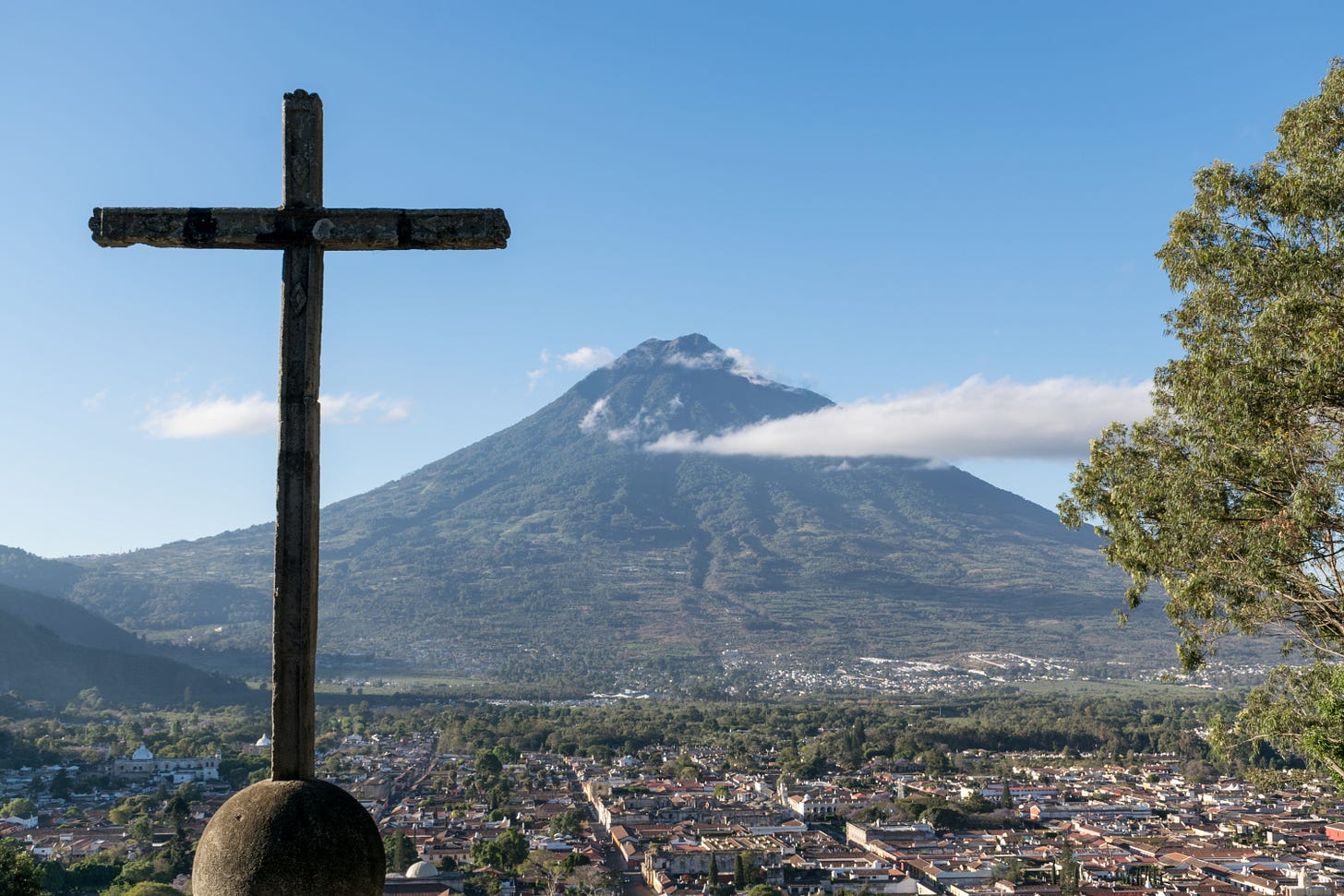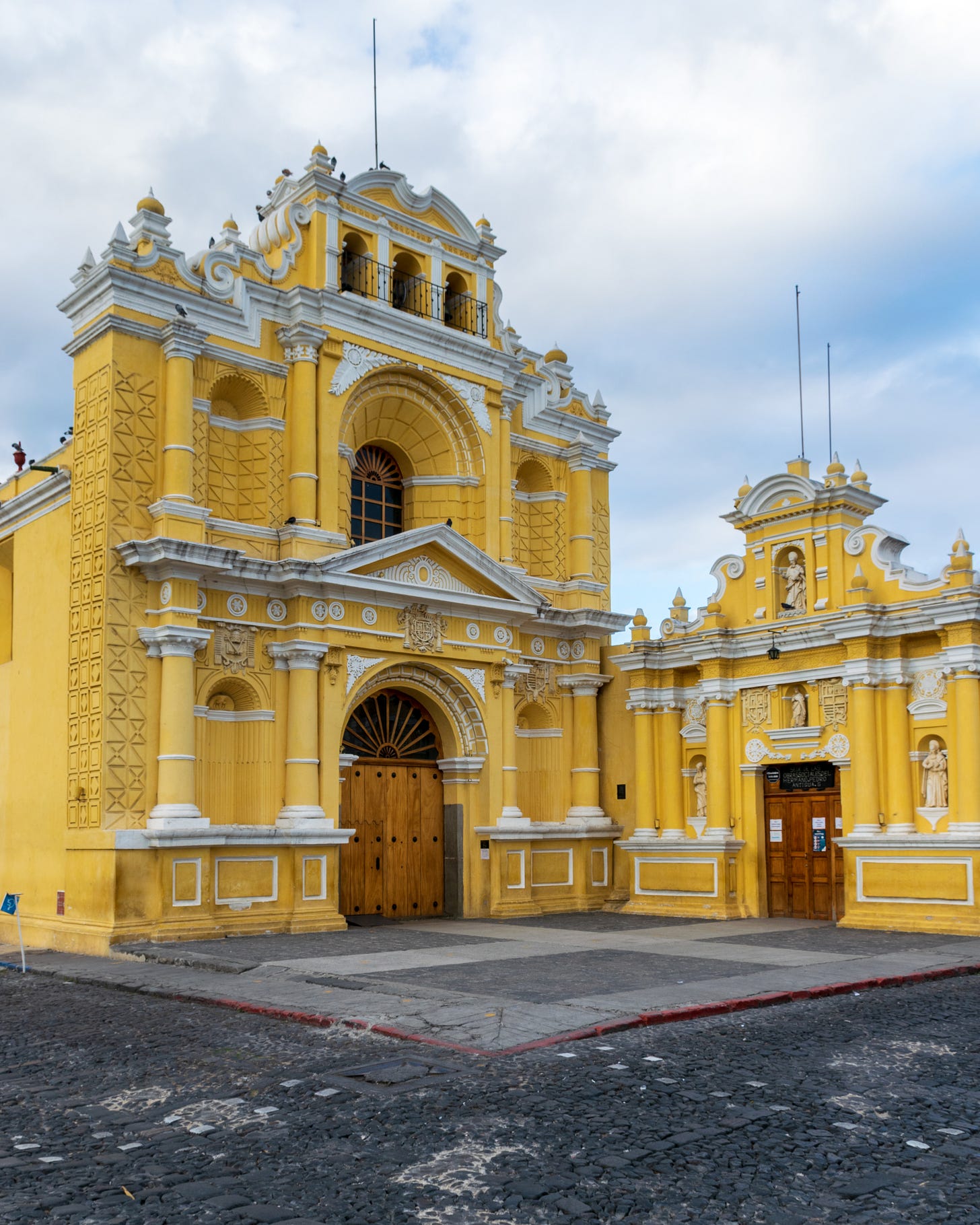My taxi car suddenly started shaking on the cobbled streets and after a drive on windy roads through a curtain of darkness, I knew I had finally arrived in the old city of Antigua. As I entered my hotel, I immediately noticed two things, there was a pleasant smell from the incense the staff burned in the courtyard and there was a sign that said the toilets do not accept toilet paper. I did not have time to ponder those things too much as I fell fast asleep after a long day of traveling.
I awoke in the morning to the sound of screaming birds and a text from the hotel asking what I wanted for breakfast. This was a great way to start my morning for the next few days. I got used to having pupusas (a thick griddle cake which is actually the national dish of El Salvador), black beans, orange juice, black coffee, and sugar biscuits. My hotel was located on one edge of Antigua’s grid system of streets, one of the best examples of early town-planning in Latin America. It was a quiet corner of a buzzing city that seemed to have a life of its own.
Just one block away from my hotel was a hectic two lane street which I would have to cross every morning to get to the city center. The smell of exhaust fumes and burning wood took me back to my childhood trips to India. The traffic had an assortment of vehicles. Pick-up trucks were filled to the brim with people, cargo and goats alike, the wheels sagging down with the weight. Flimsy tuk-tuks bounced on their three wheels through the cobblestone streets. Scooters and motorcycles zipped through the traffic with most drivers wearing masks, but no helmet (one dashing passenger even carried a large Samsung TV). Colorful chicken buses in whimsical designs made sharp turns in the streets with a large roar and a puff of black fumes. If the turn was too quick, luggage would sometimes fall off the roof which was filled with an mishmash of things. A man would stand outside the door greeting passengers as he clung onto the railing with one hand. It was a scene that made me feel incredibly alive.
The streets were made of uneven cobblestones and the sidewalks were very narrow, reminiscent of those in Cusco, Peru. Colorful homes with worn wooden doors dotted the streets and windows were tightly guarded with bars. Hole in the door restaurants would sell fruit juices and coffee while small convenience stores would have women making tortillas on the side. The central market sold everything from apples and avocados to artisanal handicrafts including colorful clothes, reminding me again of Peru. The town square was full of greenery and pigeons, merchants would peddle their trinkets and vendors with little carts would sell ice cream. Local ladies dressed in traditional clothing would walk through the streets carrying their wares finely balanced on their head. With churches and fountains as backdrops, it was a magnificent place to people-watch.
This small city of Antigua was once the capital of the Spanish Empire in Guatemala. After several centuries of prosperity, a series of earthquakes largely destroyed Antigua and the city was partially abandoned and the capital was moved to Guatemala City. These ruins are scattered throughout the city and range in a state of rubble to largely well preserved. The architectural style that developed in the city was called barroco antigueño, a unique twist on the Baroque style in Europe but specifically designed to withstand earthquakes. The city was full of many churches and monasteries which testify to the influence of the church. These buildings continue to serve as artifacts to the legacy of Spanish colonization.
I felt like Indiana Jones exploring the ruins of La Recolección, an old church and monastery that was now in complete ruins, with large chunks of masonry sprawled across the site. Other sites were slightly more cleaned up and restored like the Convento Santa Clara. From the garden I could see the green hills surrounding the old city, the same green hills that the nuns living in this large religious complex must have gazed out to. There were endless ruins like this, many with impressive facades and ornate statues. Today these churches may be home to mostly pigeons and cats but at its peak, Antigua was the cultural, economic and religious center of the whole region.
There are a number of colorful buildings throughout the city, besides the old ruins. Banana yellow churches like the Iglesia de la Merced or San Juan de Dios Convent Church were examples of the city’s unique architecture. There is the Tanque La Union, a mid-nineteenth century public laundry basin that is still used by some locals today. The most distinguishable building in Antigua is the Arco de Santa Catalina. It was built in the 17th century to allow for nuns passing from one building to the other without being seen in the street. It was a beautiful soft yellow color and had a clock tower on its top where birds were perched. I would make it a point to walk to the arch each morning. Men would be throwing water to clean the streets in front of their stores and passersby would greet me with a friendly ‘Buenos Dias’. In the distance, a volcano would occasionally blow a plume of smoke serving as a reminder to the active geological activity in the area.

On my last morning in the city I continued walking past the arch and climbed slowly up the streets. The sun was already strong and warming up the day. I passed by the residential backstreets of the city and passed by the most adorable puppies and eventually made my way to my final destination, Cerro de la Cruz. I was on a hillside, on the north side of Antigua, and in front of me was a large cross and sweeping views of the historic center of the city. Good fortune smiled on me and for the first time on the trip, the clouds parted and I got unobstructed views of Volcan Agua, towering over Antigua and dominating the landscape.

As I walked back to my hotel, I felt something brush against my leg and at first glance thought it was a street dog. Looking back, I saw it was in fact a goat, one of about a dozen that were being shepherded back to a pick-up truck.
This city has a rare charm and seems to have found a balance between maintaining a genuine old-world way of life and embracing tourism and all that comes with it. It is a city to be experienced, not just by sights but also by sounds and smells and moments like this.









I could actually picture myself there based on your wonderful descriptions! The photographs are beautiful Abhi!